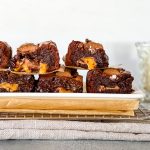
Chocolate Brownies with Caramel Squares and Sea Salt
Melt in the mouth, soft, fudgy, rich and gooey on the inside, these Salted Caramel Brown Butter Brownies are studded with squares of Cadburys Caramel chocolate and topped with an extra sprinkling of sea salt.
Ingredients
- 200g unsalted butter, in cubes
- 200g dark chocolate, 70% cocoa solids, broken into pieces
- 150g soft brown sugar
- 50g caster sugar
- 3 eggs
- ¼ teaspoon fine salt
- 100g plain/all-purpose flour, sieved
- 25g cocoa, sieved
- ½ teaspoon instant coffee powder, sieved
- 360g/3 bars Cadbury Dairy Milk Caramel Bars
- sea salt for sprinkling on the top
Instructions
-
Collect together your equipment (see Recipe Notes below) and ingredients.
-
Preheat oven to fan oven 170°C /190°C/375°F/Gas 5
-
Chop the butter into squares and place in a microwave safe bowl with the chopped chocolate. Melt in a microwave or a bain marie or and mix until smooth. (See Recipe Notes for details.)
-
Meanwhile put the sugars, eggs and salt in a mixing bowl and whisk with an electric whisk until thick and creamy. This will take around 3 minutes.
-
Pour the chocolate and butter into the eggs and sugar, whilst whisking, and mix thoroughly with the electric whisk until smooth and glossy.
-
Put a sieve over the bowl and add the flour, cocoa and coffee and sift directly over the cake batter.
-
Fold until completely mixed in but be careful not to over-mix.
-
Transfer half of the mixture to your lined baking tin and level the surface, making sure the cake batter goes all the way into the corners.
-
Set 16 squares of Chocolate Caramel aside and evenly divide the rest over the surface of the brownie batter.
-
Top with the remaining cake batter, again levelling the surface and making sure the cake batter goes all the way into the corners.
-
Top the cake batter with the 16 Chocolate Caramel squares – I place a square roughly in the centre of each brownie – and sprinkle a little sea salt over the top of each chocolate square.
-
Bake in the centre of the pre-heated oven for 20 – 25 minutes, depending on how squidgy you like the centre to be. (I cook mine for 23 minutes in London and 24 minutes in Switzerland.) This gives me a slightly crispy top but a gorgeous gooey centre. The cake will be slightly risen and cracked around the edges but the centre will feel quite soft. Remember the cake will continue to cook after you have taken it out of the oven.
-
Leave to cool in the tin for around 30 minutes and then transfer, in the baking parchment, to a cooling rack.
-
Slice into 16 small squares.
Recipe Notes
Equipment
- Large microwave safe jug or heatproof bowl
- Electric whisk and mixing bowl
- Kitchen scales and measuring spoons
- Sieve
- Chopping board and knife
- 20cm/8inch square baking tin lined with baking parchment
Be very careful melting the chocolate. Chocolate can be very difficult to work with. You can overheat it very easily and the mixture will go grainy. When this happens, there is no way to resolve it I’m afraid!
Microwave: I give the chocolate and butter a minute in the microwave, take it out and stir it well, then let it sit for a few minutes to see if it continues melting sufficiently to melt all the chocolate. If not, I then continue with the microwave but in 10 – 15 second bursts.
Bain Marie: if you do not have a microwave, put the chocolate and butter in a heatproof bowl over a saucepan of gently simmering water. Do not let the base of the bowl touch the water. Heat until the chocolate and butter are very nearly melted then take it off the heat and take the bowl off the saucepan. Be very careful not to burn yourself as the bowl will be hot and steam will escape from the saucepan. Allow the mixture to sit for a few minutes for the residual heat to melt the remainder of the mixture. Again, be careful not to over-heat.